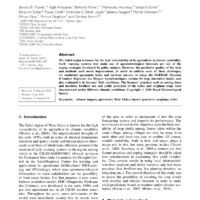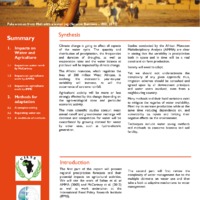Recherche
2 items
Characterizing and modeling the diversity of cropping situations under climatic constraints in west africa
The Sahel region is known for the high vulnerability of its agriculture to climate variability. Early warning systems that make use of agrometerological forecasts are one of the coping strategies developed by policy makers. However, the predictive quality of the tools and methods used needs improvement. In order to address some of these challenges, we conducted agronomic trials and on-farm surveys to adapt the SARRAH (Syst`eme d’Analyse R´egionale des Risques Agroclimatiques, version H) crop simulation model, and also evaluated it in farmers’ field conditions. The farmers’ practices such as sowing dates and densities, fertilizer use and yields potentials of the millet and sorghum crops were characterized under different climatic conditions.
Climate change impacts on water and agriculture in west africa
Climate change is going to affect all aspects of the water cycle. The quantity and distribution of precipitation, the frequencies and duration of droughts, as well as evaporation rates and the water balance at plot level will be impacted by climate change. The African monsoon, which regulates the lives of 300 million West Africans, is evolving: the monsoon’s year-to-year variability will increase, as will the occurrence of extreme rainfall. Agricultural activity will be more or less strongly affected by this change depending on the agro-ecological zone and particular economic activity. The main scientific studies concur: mean annual runoff and groundwater recharge will decrease and competition for water will be exacerbated by growing demand for water by other uses, such as hydro-electric generation. Studies conducted by the African Monsoon Multidisciplinary Analysis (AMMA) are clear in stating that the variability in precipitation both in space and in time will be a real constraint on farm production. Society will need to adapt. Yet we should not underestimate the complexity of any given approach; thus, irrigation schemes should be consulted and agreed upon by all downstream principals and water users involved, even from a neighbouring country. Many methods and their local variations exist to mitigate the vagaries of water availability. Most try to increase production while at the same time reducing dependence on, and vulnerability to, inputs and limiting their negative effects on the environment. Techniques include water saving methods and methods to conserve biomass and soil fertility.

